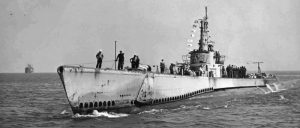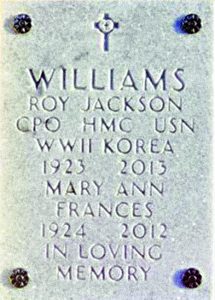Life’s path is never straight, nor is it clear as one looks forward. One never knows the twists and turns to expect on that path and many, upon knowing, might decide not to go forward at all. Roy Jackson Williams Jr. left Floyd in 1940 for service in the United States Navy, having no idea where his path would take him.
Roy Jackson Williams, Jr., was one of two children born to Roy Jackson “Bud” Williams Sr. and his second wife, Edna M. Epperly. Bud had started out as a motorman in Dayton, Ohio, but moved back to Floyd after the death of his first wife, Lillian Via. Bud set up shop in the Town of Floyd as a barber and served as Mayor in the 1940s.
Growing up in town, Roy Jr. and Jack attended public schools and graduated from Floyd High School. Upon graduation, Roy entered the United States Navy. This is a big decision to make in general, but would prove to be life-changing after the Japanese bombing of Pearl Harbor and the Philippines Territory on December 7, 1941.
Roy began his naval career after boot camp by attending Hospital Corpsman School and Dental School. He was initially stationed at the University of Wisconsin. When war broke out in 1941, Roy requested assignment to the submarine service. After an eight-week cram course for Submarine-Pharmacist mates, he was assigned to the submarine U.S.S. Sealion (SS-315), also referred to as Sealion II. He was the only medically trained person in the crew and served on all six of Sealion’s World War II patrols.

Sealion’s first war patrol began at Pearl Harbor on May 17, 1944. On June 12, the sub was at Midway Atoll where it glanced off of a whale. Traveling all over the Pacific, the Sealion had transited Tokara Strait and entered the East China Sea by June 22nd. Finally, on June 28, Sealion sunk its first Japanese ship, Snesei Maru, a naval transport.
Sealion’s second patrol, the one that would bring it notoriety, began on September 12. United States codebreakers were able to determine the location and route of a Japanese convoy. Sealion and sister sub, Pampanito, were given the coordinates and sent to attack the convoy. Unknown to them, the Japanese were transporting 1,500 Australian and British prisoners of war from their work on the Burma Railroad. The POWs were being transported for use as forced labor on other Japanese projects.
Sealion and Pampanito made contact with the Japanese convoy on September 12. Just after 5 p.m., Sealion’s first two torpedoes missed their targets. Continuing to fire, the Sealion launched three torpedoes at a Japanese tanker and struck Zuiho Maru and Rakuyo Maru. Rakuyo Maru, the ship carrying the POWs, would eventually sink due to the damages, tragically drowning over 1,200 Australian and British prisoners.
Sealion, being hunted by at least one Japanese destroyer, escaped the area to continue its patrol. On September 15, three days after the attack on Rakuyo Maru, Pampanito found POW survivors in the water and requested help from Sealion. By 8:45 p.m., Sealion had rescued 54 survivors from Rakuyo Maru. Those 54 took up all of the available space on Sealion; sadly, some had to be left in the water to perish. Such are the harsh realities of war.
“Doc” Williams, as he was now known to Sealion’s crew, was the only medically trained crewman on board. He took over the care of the POWs who were covered in crude oil and suffering from exposure. Many had malaria or diseases caused by severe malnutrition. Williams treated these men for four days without a break until a doctor and a pharmacist’s mate were taken on board on September 19. Williams successfully saved 50 of the 54 prisoners. Sealion and her crew received a Presidential Unit Citation for WWII service. Williams’ description of his work and the condition of the men can be found in the book Return from the River Kwai, by Joan and Clay Blair Jr.
Sealion went on to sink the Japanese battleship Kongo and the destroyer Urakaze on November 21, 1944. Eventually, Sealion was ordered to assist in the retaking of the Philippine Islands. Sealion received five battle stars during WWII and remained active until being decommissioned in 1970. She was eventually sunk as a naval practice target off Newport, R.I., on July 18, 1978.
Having turned down a promotion to warrant officer with the submarine fleet, Williams did continue a career in the Navy. While his service on Sealion was the most notable, he went on to be a part of another historic event. Williams was assigned to the U.S.S. Triton, the U.S. Navy’s largest and most powerful nuclear-powered radar picket submarine. Triton was commissioned November 10, 1959.
While a member of Triton’s crew, Williams was a participant in Operation Sandblast as Triton and her crew secretly conducted the first submerged circumnavigation of the world. Beginning February 24, 1960, Triton followed the legendary route of Ferdinand Magellan, a distance of 26,723 nautical miles. Triton crossed the equator four times and completed continuously submerged circumnavigation in 60 days and 21 hours. Williams was part of a second Presidential Unit Citation when Triton received the second ever peacetime citation issued to a submarine.
Shortly after the completion of Triton’s voyage, Williams retired from Naval service in 1960 and ended his journeys around the world under the sea.
Roy Jackson Williams Jr. passed away April 17, 2013, in Livermore, California. His obituary noted that he was survived by his wife, Maryan Frances Swartz Williams, and a daughter. The obituary further noted that Williams’ life “had been blessed with many special people as he served God in his vocations at home, church, work, and in the community.”

The Floyd County Historical Society 217 North Locust Street, Floyd VA
www.FloydHistoricalSociety.org
540-745-3247
